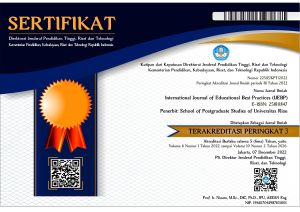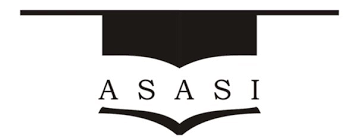THE EFFECT OF COMBINATION OF NUMBER HEAD TOGETHER AND TWO STAY TWO STRAY LEARNING MODELS ON MATHEMATICAL LEARNING OUTCOMES AND ACTIVENESS OF SENIOR HIGH SCHOOL STUDENTS
DOI:
https://doi.org/10.31258/ijebp.4.2.78-87Keywords:
Learning Effect, Combination of Learning Models, NUmber head Together, Two Stay Two StrayAbstract
An engaging learning process will affect learning outcomes and student activeness during the learning process. The present study was conducted to investigate the effect of the combinatory use of Number Head Together and Two Stay Two Stray learning models on the scores of high school students’ mathematical tests and learning activeness. It was an experimental-based study with One Group Pre test Post-test design. The population of this study was all high school students in Kendari, with Cluster Random Sampling as the method to choose the sample. Final test and observation were used as instruments to collect data. The data were analyzed using descriptive and inferential statistics with the One Sample t-test. Results showed that (1) the combinatory use of both learning models improved learning outcome by increasing students’ average test scores from an average score of 68 (pre-test) to an average of 83 (post-test) with a gain value of 0.71; (2) the learning models had a positive influence on student activeness during the learning process, proven by a score of 3.3 (positive category). It was also evidenced by the results of the t-test showing that the t-count score was greater than the t-table. Therefore, the combinatory use of Number Head Together and Two Stay Two Stray learning models has a significant effect on increasing the learning outcome and learning activeness of high school students in the mathematic class.
References
Adhini, I. N. (2017). The Use Numbered Head Together Technique on Students’ Reading Ability in Narrative Text Collaborative/Cooperative Learning. English Language and Literature International Conference (ELLIC), 124–128.
Adianto, S. (2018). Increased Activity, Motivation, and Learning Outcomes Mathematics with Learning Model Cooperative Type Numbered Head Together in Grade III Students. IJECA (International Journal of Education and Curriculum Application), 1(3), 35. https://doi.org/10.31764/ijeca.v1i3.2123
Anwar, K., Ari, T., Sri, S., Widodo, A., & Pendahuluan, A. (2018). Pengaruh Model Pembelajaran Kooperatif Tipe Numbered Heads Together ( Nht ) Terhadap Prestasi Belajar Matematika Siswa. Prosiding Seminar Nasional Etnomatnesia, (6), 790–794.
Batubara, N. A. (2019). the Effect of Using Cabri 3Dv2Plus Software With Cooperative Interaction Setting Learning Model on Students’ Mathematical Understanding in Transformation Materials. International Journal of Educational Best Practices, 3(1), 50. https://doi.org/10.31258/ijebp.v3n1.p50-61
Creswell, J. W. (2012). Educational Research Planning, Conducting, and Evaluating Quantitative and Qualitative Research (Fourth Edi; P. A. Smith, Ed.). Boston Columbus Indianapolis New York San Francisco Upper Saddle River Amsterdam Cape Town Dubai London Madrid Milan Munich Paris Montreal Toronto Delhi Mexico City São Paulo Sydney Hong Kong Seoul Singapore Taipei Tokyo: Pearson.
Ervin Tamta Lirnawati, Mardiyana, D. R. S. S. (2017). The Efforts to Improve Mathematics Learning Activity Using Cooperative Learning Model Type Two Stay Two Stray in Linear Program Material Student Class XA SMK Muhammadiyah 1 Kalasan. In Juhansar & T. Widodo (Eds.), Proceeding of the 5th International Seminar on Quality and Affordable Education. Jl. Ringroad Utara, Jombor, Sleman - Yogyakarta: Faculty Of Education Campus 1 Universitas Teknologi Yogyakarta Jl.
Fitriani, I., Saragih, S., & Murni, A. (2020). Developing Learning Documents Using Assure Design With Problem-Solving Strategy On Social Arithmetic Materials To Increase Mathematical Problem-Solving Ability. International Journal of Educational Best Practices, 4(1), 53–63. https://doi.org/10.32581/ijebp.v4n1.p53-63
Habibahi, U., Aisyiyah, N., & Ningrum, L. I. (2012). Studi Tentang Status Perkawinan Mahasiswa Reguler Pgsd Tegal Hubungannya Dengan Prestasi Akademik. Journal of Elementary Education, 1(1).
Harahap, K. A., & Surya, E. (2017). Application of Cooperative Learning Model With Type of Two Stays Two Stray to Improve Results of Mathematics Teaching. International Journal of Sciences: Basic and Applied Research (IJSBAR), 33(2), 156–165.
Hendrayati, H., Egryas, R., & Achyarsyah, M. (2018). The Trial of the Cooperative Learning Models of Two Stay-Two Stray and Talking Stick on Students’ Mathematical Communication. Advances in Social Science, Education and Humanities Research, 253(Aes 2018), 317–321. https://doi.org/10.2991/aes-18.2019.74
Huda, S., Yasin, M., Fitri, A., Syazali, M., Supriadi, N., Umam, R., & Jermsittiparsert, K. (2020). Numerical Ability Analysis: The Impact of the Two Stay-Two Stray Learning Model on the Sequence and Series Topic in Islamic Boarding School. Journal of Physics: Conference Series, 1467(1). https://doi.org/10.1088/1742-6596/1467/1/012002
Kaharuddin, A. (2019). Effect of Problem Based Learning Model on Mathematical Learning Outcomes of 6th Grade Students of Elementary School Accredited B in Kendari City. International Journal of Trends in Mathematics Education Research, 1(2), 43–46. https://doi.org/10.33122/ijtmer.v1i2.14
Naibaho, L. (2020). the Effectiveness of Number Head Together Strategy on Improving Students’ English Achievement At Xyz School. International Journal of Research -GRANTHAALAYAH, 7(10), 362–370.
https://doi.org/10.29121/granthaalayah.v7.i10.2019.406
Nurhasannah. (2016). Penerapan Metode Two Stay Two Stray (TSTS) dengan Metode Number Head Together (NHT) dalam Meningkatkan Aktivitas Belajar Siswa. Bandung.
Pinontoan, M. (2019). Number Head Together Model in Social Learning. Advances in Social Science, Education and Humanities Research 5th International Conference on Education and Technology (ICET 2019) Number, 382(Icet), 212–216. https://doi.org/10.2991/icet-19.2019.54
Sinta, T., Putratama, A. A., & Pratama, F. W. (2019). International Journal of Active Learning A Comparison of The Learning Outcomes Resulted from Jigsaw and TSTS Learning Models Viewed from The Students ' Self Regulated Learning. International Journal of Active Learning, 4(2), 78–87.
Sudrajat, A., Iasha, V., & Femayati, F. (2018). The Influence of the Use of Cooperative Learning Model Jigsaw & Two Stay Two Stray and the Learning Interest Result on 5th Grade Social Science. Proceeding Book of 1st International Conference on Educational Assessment and Policy, 2, 28–33. https://doi.org/10.26499/iceap.v2i1.92
Suparlan, A. (2011). Eksperimentasi Pembelajaran Kooperatif Tipe Numbered Heads Together (Nht) dan Tipe Two Stay Two Stray (Tsts) Pada Pembelajaran Matematika Ditinjau Dari Intelligence Quotient Siswa Kelas Viii Smp Di Kabupaten Tahun Pelajaran 2011/2012 (Vol. 53).https://doi.org/10.1017/CBO9781107415324.004
Suwangsih, E., Budiarti, M. R., Ruskandi, K., Hendawati, Y., & Majid, N. W. A. (2019). Two-stay two-stray model on improving mathematical communication skill of elementary school students. Journal of Physics: Conference Series, 1318(1). https://doi.org/10.1088/1742-6596/1318/1/012127
Turmuzi, M. (2017). Meningkatkan Kemampuan Berpikir Kritis Pada Perkuliahan Geometri Bilangan Kompleks Dengan Discovery learning Dipadukan Dengan Cooperative Learning Tipe NHT ( Numbered Head Together ). Prosiding Seminar ELPSA, (April), 57–67. Nusa Tenggara Barat: IKIP Mataram.
Umar, U., Kaharuddin, A., & Erfan, M. (2020). A Comparative Study on Critical Thinking of Mathematical Problem Solving Using Problem Based Learning and Direct Intruction. Proceedings of the 1st Annual Conference on Education and Social Sciences (ACCESS 2019) A, 465(Access 2019), 314–316. Atlantis Press.
Winarti, A. (2016). Increasing Effectiveness of Number Head Together ( Nht ) Model Through Integration of Multiple Intelligences Theory in Chemistry Lesson. Proceeding Of 3rd International Conference On Research, Implementation And Education Of Mathematics And Science, (May), 16–17.





